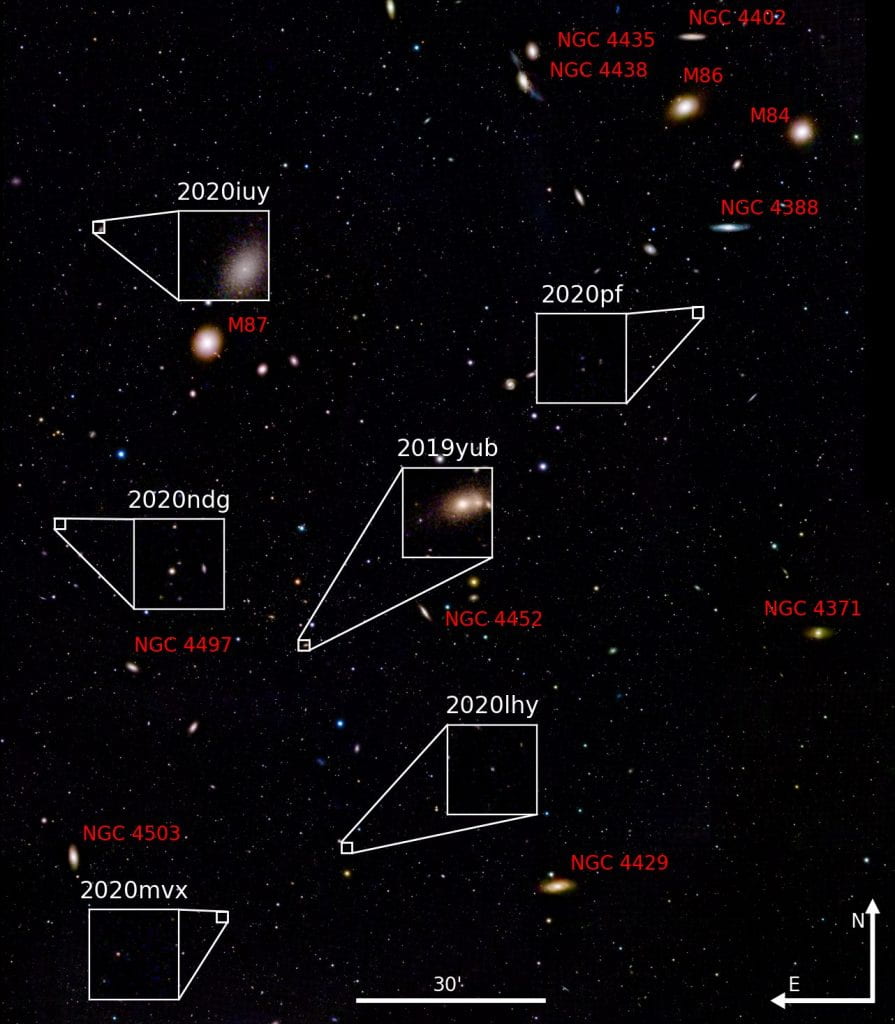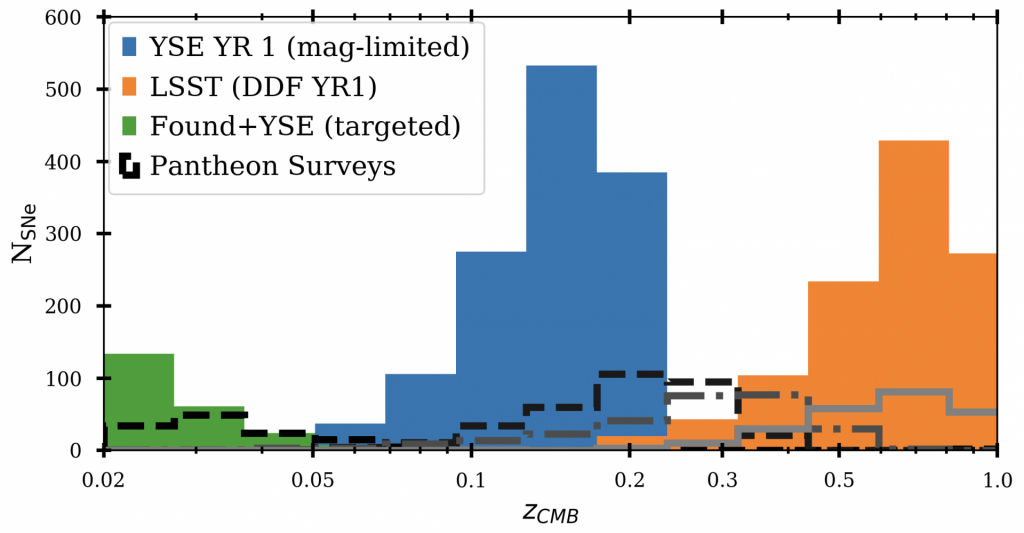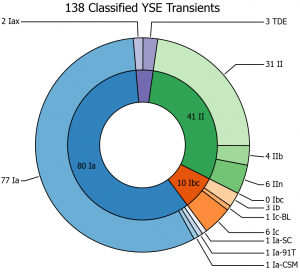Young Supernovae
Observations within the first hours or days of explosions offer a unique window into understanding the progenitor systems of supernovae. In the case of supernovae from massive stars (core-collapse SNe), the shockwave from the supernova will “flash” ionize the material shed by the star in the final stages of its evolution allowing its chemical abundances and mass-loss history to be understood. In the case of thermonuclear (Type Ia) supernovae, early observations constrain the explosion mechanism of the white dwarf progenitor and the possible presence of a binary stellar companion.

YSE will carry out a survey of 1500 square degrees of sky that is deeper than other ongoing time-domain surveys, giving it a unique chance to catch a rapidly brightening transient explosion – or the absence of an explosion – just one day before other surveys observe the same location. The combination of data gives YSE constraints on the age of the SN and the chance for quick follow-up observations.
Rare, Fast, and Faint Transients
YSE is uniquely sensitive at red wavelengths, which gives it the opportunity to discover faint and red transients that are missed by more blue-sensitive surveys. Intermediate-Luminosity Red Transients and Luminous Red Novae – caused by stellar outbursts and mergers – are examples of the types of faint transients for which YSE can discover and understand their diversity. YSE images stacked over week and month timescales can be used to find long-lived, faint transients such as gravitationally lensed supernovae and superluminous supernovae.

Cosmology with Type Ia Supernovae
YSE will help to answer some of the most fundamental questions regarding the physics of our universe: the nature of dark energy, the laws of gravity, and the reason why measurements of the local cosmic expansion rate (the Hubble constant) appear to be faster than expected from early universe data.

YSE will re-build the sample of nearby Type Ia supernovae, so-called “standard candles” for measuring cosmic distances. The nearby Type Ia supernova sample currently is subject to selection effects that contribute to large systematic uncertainties on cosmological parameters. YSE data will build a sample of thousands of SNe Ia with simple selection effects and coverage at red wavelengths where SNe Ia are more precise distance indicators. The YSE SN Ia sample will have the statistical leverage not only to measure dark energy better than ever before but to also constrain the nearby growth of structure and put meaningful constraints on General Relativity.
Black Hole Variability and Tidal Disruption Events
YSE will carry out a large multiwavelength variability survey that will specifically contribute to a better understanding of the population of “elusive” active galactic nuclei in low-mass galaxies. A fraction of YSE AGN will evolve dramatically over a period of years, which serves as a test of black hole accretion physics and the build-up of accretion disks around the black hole. Finally, early observations of stars torn apart by black holes (Tidal Disruption Events) can help to constrain the distribution of black hole masses especially at the low-mass end.
Preparing for the Rubin Observatory

The Vera C. Rubin Observatory will transform time-domain astrophysics by discovering approximately 105 transient events per year, with observations in four photometric filters. Sorting through this wealth of data and selecting uniquely interesting and scientifically valuable events for follow-up observations is key to achieving the best possible understanding the physics of stellar explosions over the next decade. YSE will provide a “test set” of thousands of light curves for training machine learning algorithms, understanding the biases inherent in classifications based on broadband photometric light curves alone, and optimizing transient discovery and follow-up procedures.
Census of Astrophysical Transients

The rates and luminosity distributions of many types of rare stellar explosions are uncertain. This uncertainty propagates to uncertainty in photometric classification of supernovae, stellar evolution, the physics of SN explosions, and the chemical enrichment of the universe. YSE will compliment a number of ongoing surveys – ASAS-SN, ATLAS, ZTF – that will obtain volume limited samples for many types of transient events. However, YSE will be particularly unique in its sensitivity to very red transients and those transients in dusty environments.
Deep Images of the Static Sky
Deep stacked observations will allow YSE to contribute to science beyond just time-domain astrophysics. Anticipated stacked image depths from YSE are given below.
| Survey | Area (deg2) | g | r | i | z |
|---|---|---|---|---|---|
| PS1 3pi | 30000 | 23.3 | 23.2 | 23.1 | 22.3 |
| SDSS | 15044 | 23.3 | 23.1 | 22.3 | 20.8 |
| DES DR1 | 5186 | 24.3 | 24.1 | 23.4 | 22.7 |
| KiDS DR4 | 1006 | 25.1 | 25.0 | 23.7 | – |
| YSE+3pi 1-year | ~5000 | 23.6 | 23.7 | 23.6 | 22.9 |
| YSE+3pi 3-year (deep) | ~2000 | 24.0 | 24.2 | 24.1 | 23.3 |
| YSE+3pi 3-year (wide) | ~7000 | 23.6 | 23.7 | 23.6 | 22.8 |